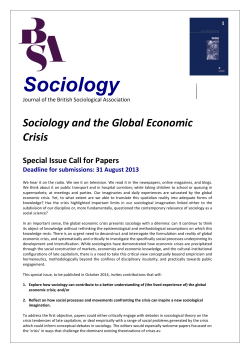
Locating Sociological Concepts in Business Games Dylan Kissane
Locating Sociological Concepts in Business Games Dylan Kissane Helen Roux-Fontaine Centre d’Etudes Franco-Américain de Management Lyon, France Introduction Business schools are explicit in their mission to educate the next generation of professionals in the fields like management, marketing, finance and accounting. While often supplementing core courses with selections from the liberal arts and social sciences in order to offer a broader education to students, such courses are routinely considered as peripheral by school administrators and students, focussed as they are on their core business majors, often fail to make the connection between concepts in social science and their future careers. The challenge for the professor of social sciences, then, is to present their course and their social concepts in such a way as to prove their value to the student and highlight the benefits that understanding social concepts and issues can bring. This article describes one strategy for demonstrating the value of sociological concepts to business students by adopting a cross-discipline approach to a business game at a French-American business school. This strategy proved effective in allowing a social science professor to demonstrate the practical implications of two concepts – gender and race – to undergraduate students while simultaneously allowing an international management professor to demonstrate how cross-cultural teams should be managed in order to work effectively. This article first explains the Ecotonos business game; secondly, it explains the crucial debriefing process for the business game and demonstrates how sociological concepts can be highlighted in an international management simulation; thirdly, it argues that business games are an effective pedagogical tool for teaching social science concepts; fourthly and finally, in concluding the article it is suggested that using games in core courses in a business school to demonstrate social science concepts is an effective way of demonstrating the utility of those concepts in future business careers. The Ecotonos Business Game Ecotonos is a business game that, according to its creators, is designed to allow participants to “improve their skills and strategies for multicultural collaboration and teamwork”. 1 The game itself is simple. Briefly, participants are divided into three ‘cultures’, each of which has been allocated certain cultural traits related to communication style, personal space and body language, social relationships, language and orientation towards time. For example, a group may be told that their 1 Nipporica Associates. 2010. Related Intercultural Products and Services. [27 December 2010] http://bit.ly/hM2ItK. The Councilor: The Journal of the Illinois Councilor for the Social Studies Vol. 72 No. 2 1 culture uses a special hand gestures to demonstrate agreement, that their culture demands that people who are speaking must be closer than a yard and that they must maintain eye contact with others lest they be thought rude. Other groups will be allocated cultural traits that are in opposition to these (for example, a person may never touch another person or eye contact must always be avoided) and participants are given a short time to acclimatise to their cultural traits within their mono-cultural groups. This acclimatisation includes a period of creative ownership when players are given time to invent the origins of their culture (represent in a visual and written forms on poster paper) and encouraged to explain the emergence of the cultural traits. This creative ownership ensures that participants have time to justify, incorporate and ‘own’ their allocated cultural markers. Following this period of acclimatisation, the three cultures are given a task to begin. For example, participants are asked to begin building a bridge between two desks approximately five feet apart using craft materials (paper, drinking straws, glue, plasticine) with the only guidelines being that the bridge must be ‘both strong and beautiful’ and that cultures should maintain their cultural traits. Importantly, participants are only expected to begin the task but not to complete their task before the second half of the exercise begins. After a short period, the instructor asks all groups to stop and for a certain number of participants to trade places with participants in other groups. The number of participants leaving each group is determined by two factors: the number of overall participants and the final composition of the ‘mixed’ groups. The resulting mixed groups have three different compositions which are always the same: a ‘joint venture’ group with equal numbers of members from two different cultures, a ‘majority/minority’ group with a cultural mix ratio of 3:1, and a ‘tri-cultural’ group of approximately equal numbers from each culture. This allows the game facilitators to observe the impact of two sources of perceived strength: that which can come from a territorial perspective, where the new members are ‘on our turf’ and so should respect the local culture and the work accomplished thus far, or from a ‘numerical’ perspective where, for example, majority opinion rules. Significantly, while the instructor asks, for example, six people to leave Group 1, the instructor does not select the people who will leave; this is left to the group to decide. 2 After all groups have been shuffled, the instructor asks the new groups to finish the task and to continue maintaining their cultural traits. As a result, groups that had been mono-cultural are forced to deal with multicultural issues and issues arising from the inability to effectively communicate in a time-limited and task-driven environment. Finally, when the time for the task has expired, the instructor asks 2 Experience with the game suggests that members are usually reluctant to leave their group. Observation of multiple games suggest different reasons for this reluctance: affinity with group members (which pre-date the exercise or have just arisen), a feeling of comfort relative to the assigned cultural traits, an feeling of inclusion or bonding towards the original group and pride in the parts of the bridge already constructed. 2 The Councilor: The Journal of the Illinois Councilor for the Social Studies Vol. 72 No. 2 the participants to stand in front of “their bridge” for a group photo. Participants are not told whether “their bridge” is the one that they began to build or the one the bridge of the group they joined half way through the game; this decision is left up to the participant alone to decide.3 Debriefing the Ecotonos Game Photos taken, the game then moves to the debrief stage where the instructor both elicits reactions from participants about their experiences in multi-cultural working environments and offers commentary on the dynamics of the groups from the perspective of a non-participant. The end goal of the game is that participants understand the difficulties of working in a multi-cultural environment and develop skills to overcome problems they encountered. In this case, though, the debrief was extended by the addition of a social science professor who had observed the game and was teaching the same cohort of students sociology. With less of a focus on management and working in cross cultural environment and more of a focus on the practical side of concepts such as gender and race developed theoretically in sociology class, this second debriefing instructor allowed the students to consider additional elements of their behaviour not expressly pertaining to their allocated cultures in the Ecotonos game. The Ecotonos game is not designed to demonstrate to business school students the practical side of sociological notions such as gender and race. Nonetheless, gender and race issues emerged naturally and without any prompting from the cultural traits distributed to the groups or from the instructor in the room.4 For example, groups were given instructions to make their bridge ‘both strong and beautiful’ and, in two out of the three groups observed, the ‘strength’ elements of the bridge, such as the frame and lattice, were assigned to the males in the group and the ‘beauty’ elements of the bridge, including colours, flags and streamers, were assigned to the females in the group. To the observer, this separation of tasks along gender lines was obvious though, to participants, it was not recognised before prompting by the instructor in the debriefing session. Another example emerged when participants were asked to change groups. One group saw all to their male participants leave to join another group while another saw all but one of their female members depart for another group. While participants in the debrief were uncomfortable with the notion that gender had played a role in the way that groups divided at this point in the game, the gender divisions were clear to non-participating observers. Power relationships – particularly in the majority/minority group – were also easily identified and were a subject that the debriefing spent significant time discussing. The majority culture was unapologetic for taking actions that included marginalisation of those with the minority culture. Links were made to recent political events in 3 The participant’s decision is observed to be based on one of two motivating factors: social reasons (they will either return to their original group if the affinities were stronger there) or competitive reasons (they will pose with the bridge they subjectively consider as being better). 4 These examples relate to the game as played by undergraduate management students at CEFAM in Fall 2010. 3 The Councilor: The Journal of the Illinois Councilor for the Social Studies Vol. 72 No. 2 France and Europe where more powerful majority cultures have excluded minority groups enabling students to make concrete links between power differentials in a small group and the same differentials at a national or regional level. Finally, one group consisting of seven white Europeans and one black African divided their tasks not by gender but by race. The sole black group member was allocated the largely inactive role of supporting the centre of the bridge while other group members built in supports, added design elements and debated how the project should proceed. The black group member spent the majority of the working time seated and did not play any active role despite, outside of this game, being an active student in the classroom. When confronted with this ‘natural’ allocation of tasks during the debrief, members of the group were very uncomfortable with the implication that race had played a part in their decision making process but, to their credit, remained open to the idea that elements such as race could impact the functioning of multi-cultural teams in a business environment. The Efficacy of the Business Game for Demonstrating Social Science Concepts Students who participated in the Ecotonos game as part of an international management class were concurrently enrolled in a sociology and public affairs class where issues such as gender and race were key concepts. Perhaps typically for business students who are obligated to complete social science courses alongside their core major courses in management, marketing, finance and accounting, it takes much effort on the part of the professor to engage students in debate and discussion of sociological concepts that seem unrelated to their “real life” future careers. One way that has proven effective in the past at engaging students is to use games and role playing exercises. This particularly true when teaching social and sociological concepts, with a record of more than 40 years of sociological pedagogy supporting this conclusion. 5 Yet while sociology-specific games have proven effective at teaching social concepts, the need to link these concepts to future careers for the specific audience of a business school remains. The idea of, for want of a better word, piggybacking a sociology class onto an international management class’s overcomes this problem by utilising a proven and effective pedagogical technique, allowing for demonstration and discussion 5 See, among many others, Cathy Greenblat. 1971. ‘Simulations, Games, and the Sociologist.’ The American Sociologist 6(2): 161-164; Cathy Greenblat. 1973. ‘Teaching with Simulation Games: A Review of Claims and Evidence.’ Teaching Sociology 1(1): 62-83; Marie Withers Osmond. 1979. ‘The Use of Simulation Games in Teaching Family Sociology.’ The Family Coordinator 28(2): 205-216; Roger Straus. 1986. ‘Simple Gales for Teaching Sociological Perspectives: Four Examples of the Do-It-Yourself Approach.’ Teaching Sociology 14(2): 119-128; Dean Dorn. 1989. ‘Simulation Games: One More Tool on the Pedagogical Shelf.’ Teaching Sociology 17(1): 1-18; Timothy Brezina. 1996. ‘Teaching Inequality: A Simple Counterfactual Exercise.’ Teaching Sociology 24(2): 218-224; Julian McAllister Groves, Charles Warren and Jerome Witschger. 1996. ‘Reversal of Fortune: A Simulation Game for Teaching Inequality in the Classroom.’ Teaching Sociology 24(2): 364-371. 4 The Councilor: The Journal of the Illinois Councilor for the Social Studies Vol. 72 No. 2 of social concepts such as gender and race and doing so in a way that allows students to make the link between social concepts and professional workplace situations. Conclusion Business school students tend to be focussed on their future careers and overtly marginalise subjects and courses that they cannot relate to their future careers. Oftentimes the social science courses offered to business school students become secondary concerns and teachers must work hard to ensure that their courses are not only pedagogically sound but are also tailored to be relevant to the students they are serving. By working across disciplines and piggybacking onto business games in other courses, the social science teacher has an opportunity to offer a practical example of social science concepts to students in an environment that students already accept as relevant to their future careers and, as a result, allows the teacher to demonstrate how course concepts that might otherwise seem ephemeral to the students will actually be useful in the business world. Games like Ecotonos, then, should not be seen as pure business games alone but also opportunities for the social science teacher to demonstrate the breadth and utility of their disciplines to students who would otherwise see them as peripheral to their core studies in business. 5 The Councilor: The Journal of the Illinois Councilor for the Social Studies Vol. 72 No. 2
© Copyright 2025













